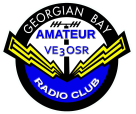2021-06-17, 17:39:08
(2020-11-13, 16:39:53)Hi John.Are you still testing out NVIS antennas? I found this thread while searching for 40m NVIS antennas, which I just acquired. I am in Newmarket and would like to see if I can make any contacts. Any advice would be appreciated.PatrickVE3BYDVA3KOT John Wrote: If you haven't looked at NVIS operation recently, forget nearly everything you thought you knew about it. As Bob Dylan used to sing: "the times they are a-changing". Actually, what has changed is the solar cycle.
Near Vertical Incidence Skywave (NVIS) is the technique of using a horizonal antenna that is intentionally low to the ground in order to send a signal straight up into space. The signal - if the correct frequency is chosen - will be reflected back down to the ground by the F2 layer of the Earth's ionosphere. NVIS is used where it is necessary to communicate with another station within a radius of about 400km from the transmitting station. A NVIS antenna will usually be quite useless for longer distance communication (an exception to that will be discussed later).
The US military developed a rapid deployment field antenna called the AS2259 for NVIS operation. It comprises a vertical centre support pole with four wire elements stretching down towards the ground at 90 degrees with respect to each other. The four wires form two inverted-V dipoles - one for a daytime band and another for a night-time band. A popular ham version of the AS2259 employs 40 metres as the daytime band and 80 metres as the night-time band. It used to function very well, but not anymore; here is why:
There is a critical frequency above which signals will pass right through the ionosphere and be lost in space. For NVIS operation the critical frequency is referred to as foF2. The critical frequency is constantly changing for every location but it also varies based on the sending station's latitude and the time-of-day. The critical frequency is measured by a device called an ionosonde. To determine the foF2 for your location you must refer to the plot of foF2 from an ionosonde near your station. For GBARC, the nearest ionosonde is located at Alpena, Michigan on the US side of Lake Huron. Here is a sample plot from 13th November 2020.
As you can see from the Alpena plot, foF2 is never high enough to use the 40 metre band at our latitude. In fact, the 80 metre band - previously used as a night-time band - is the only usable band during the day. At night it would be necessary to use the "gentlemans' band", 160m, to achieve NVIS propagation. This will change as the solar cycle heads back towards its peak, but for now the old AS2259 ham-special antennas will not do a very good job.
Anybody using an AS2259 style ham antenna may protest that they are still making contacts on 40m with it. That is possibly quite true but the contacts are using regular skywave propagation, not NVIS. The propagation pattern for a NVIS antenna has the strongest signals going straight up. But the pattern also sends weaker signals off at lower angles. The -3dB points in the pattern are typically at about 60 degrees from horizontal. The -6dB points are even lower and will transmit a signal to maybe 1500km away that is only 1 S-unit (-6dB) weaker.
So if it "kinda works" why do we care about the critical frequency anyway? Maybe we don't ... unless we want to get a signal into an adjacent valley on the other side of a mountain. I was camping at Craigleith Provincial Park on the shore of Georgian Bay a couple of years ago. I wanted to check in to a net in Shelburne, Ontario on 80m. In between my station and the net control station was the Blue Mountains and the Dufferin Highlands. I strung an 80m monopole only 8 feet high, worked against ground through a Ground Tuning Unit (GTU) and keyed up with only 5 watts. My signal was copied perfectly by the other stations due to NVIS propagation.
For NVIS to work efficiently BOTH transmitting and receiving stations MUST use a NVIS antenna. In the example just given, my simple NVIS antenna's signal was received on a Beverage antenna (a very long, very low wire used for receive only). If the receiving antenna is for example a vertical, the received signal may be very weak or non-existent. A vertical antenna's "ears" are pointed down, close to the horizon with a huge null in the direction from which a NVIS signal is coming. The same is true even for a dipole mounted high above ground.
How is this relevant to GBARC? Let us imagine a situation in which we have no repeater coverage but we need to communicate anywhere within Grey County. NVIS is the answer. A NVIS net control station in, say, Owen Sound could reliably communicate all the way from Manitoulin down to Toronto, irrespective of the terrain in the region.
NVIS antennas are particularly easy to erect. A simple dipole 8 to 12 feet above ground will suffice. Actually, an antenna laid directly on the ground (a "Grasswire") can also sometimes work. It doesn't matter whether the dipole is fed in the middle, the end or off-centre, it will still radiate towards the sky. A QRP signal is sometimes desirable because the ground wave signal may otherwise interfere with the F2 reflected signal if the transmitted signal is too strong (turn off those amps!). There is some degree of D-layer absorption so it may be necessary to adjust transmitted power accordingly for best receive signal.
If anybody would like to join me in experimenting with NVIS please leave a comment to this post.



